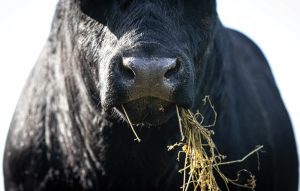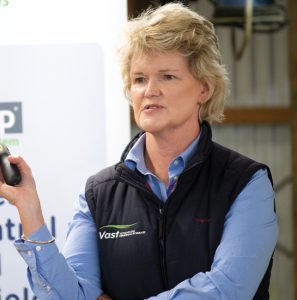Building blocks of IMF
Farming beef cattle with the right combination of genetics and raised within a strict regimented feeding plan to the appropriate processing age will result in beef carcases with the coveted intramuscular fat (IMF) demanded by consumers around the world.

By Sarah Horrocks
IMF gives beef its flavour, taste, tenderness and juiciness, and processors are rewarding farmers who deliver it in their cattle because the more there is, the more beef the consumer demands.
The process of achieving IMF begins at conception, and there are a number of opportunities throughout the year when the farmer can get things right or wrong.
 IMF develops in the perimysial connective tissue between muscle fibres, opening up and disrupting the organisation of intramuscular connective tissue, making it easier to chew. More fat within the muscle also improves the aroma and flavour of meat during cooking and eating. This is how we get tender, tasty beef.
IMF develops in the perimysial connective tissue between muscle fibres, opening up and disrupting the organisation of intramuscular connective tissue, making it easier to chew. More fat within the muscle also improves the aroma and flavour of meat during cooking and eating. This is how we get tender, tasty beef.
Farmers around the country are now selecting bulls with favourable estimated breeding value (EBV) figures for IMF because they want to breed progeny that will have good marbling at killing time. But there’s more to the equation – stock bred to deposit higher levels of IMF also need to be nourished to encourage the trait, and that nutrition starts in utero.
In a recent Head Shepherd podcast, hosted by neXtgen Agri chief executive Dr Mark Ferguson, he spoke with Dr Charlotte Westwood of PGG Wrightson Seeds about the importance of not just the quantity and quality of the feed going into animals, but also the timing throughout the lifetime that this feed is available.
While the ratio of the value of genetics to nutrition in livestock production is a well-debated topic, there’s no denying that genetics is a slower burn, whereas the results from nutrition can be seen almost immediately.
Westwood is a veterinary nutritionist who did a PhD at the University of Sydney looking at cattle reproduction and how it’s influenced by the interaction between nutrition and genetic merit. At the What’s The Beef field days earlier this year, she discussed the importance of genetics, nutrition and other management aspects when trying to increase the amount of IMF in a beef carcase.
Getting the balance right
Westwood says it’s an interplay between genetics and all aspects of management.
“We’ve got the sex effects and the age of the animal, their liveweight as a percentage of mature weight, and the time of slaughter if they’re a little bit younger.”
She says a lot of what is happening when the animal reaches its finished stage for processing has started while still in utero.
“Opportunity to improve IMF in the finishing animal actually does start inside mum’s tum, and there’s a term that’s framed the ‘marbling window’.”
While this might sound a bit mystical, the last trimester of pregnancy, from day 180–190 onwards, can influence both the number and potential future growth of the fat cells (adipocytes) within the muscle itself.
“So if we work mum a little bit too hard during the last trimester of pregnancy, that may influence the decision around stem cells inside the unborn calf – whether they’re going to turn themselves into fat cells or muscle cells or fibre cells, like collagen-producing cells.”
Westwood explains there’s a drafting gate happening during the marbling window, so if the nutrition isn’t done right during that time, it can in a small way influence future IMF deposition in the progeny.
It’s not limited just inside mum’s tum. There is some degree of plasticity around continuing to encourage more stem cells to end up as adipocytes in progeny up to about 250 days of age. Adipocytes, also known as lipocytes and fat cells, are the cells that primarily compose adipose tissue and are specialised in storing energy as fat.
“So yes, beef cows have to do what they have to do and suck it up… for other capital stock classes during winter, and work a bit harder.
“But if we are looking for … an end-to-end aspect around nutrition and IMF deposition, it does start inside mum’s tum and during that critical first 250 days.”
Westwood says if you’re looking for the added benefits that come from genetics, nutrition is a key part of the management strategy.
“You can’t run a Ferrari on 91 fuel.”
She says essentially the gestational diet of the breeding cows is what is being looked at, encouraging better foetal maternal programming for the calf. Improving cow condition at calving and feeding optimal nutrition for lactation performance and mating go hand in hand with this science.
If you’re already ticking these boxes then you’re already giving your Ferrari genetics (as Westwood terms them) the opportunity to express themselves.
What else to consider
While Westwood spoke about IMF in isolation during her presentation at the What’s The Beef field day, she did note that it shouldn’t be looked at in isolation from other aspects around productivity and profitability – growth for example.
“I wouldn’t suggest we tip a farming system on its head just to chase more IMF cells being deposited within the muscle bundles in an unborn calf, but it kicks a few goals along the way.”
She says farmers are chasing IMF in their bull-buying decisions and while, of course, the science tells them that they’ve got to have the genetics there to get that IMF into finishing progeny, they don’t want to burn those progeny by not getting their nutrition right from conception onwards.
“Some think that genetics are a silver bullet, and there are also those at the other end of the spectrum who think it’s only about feeding.”
The two work together and it is a key issue in terms of IMF predisposition. Genetics is certainly a strong attribute to part of it, like putting a jigsaw puzzle together.
“You know, if you’ve got half a jigsaw puzzle piece missing, well you’re not going to get the complete picture in the end product.”
You don’t create a premium product such as high-marbling beef by accident – you have to get all aspects of the production system right, every time.
The finishing phase is equally important with IMF, since all the different fat depots inside that animal are laid down in a specific order. First is intra-abdominal or visceral fat, which protects internal organs and serves as an energy source; the second is subcutaneous fat, deposited under the skin as an energy source and protects the skeleton from harm; third is intramuscular fat, also an energy source, though surrounding moving muscle surfaces, therefore serving to reduce friction from muscle movement. It’s not until the fourth and final stage of fattening when an animal is typically getting closer to its mature liveweight that the IMF gets laid down.
If things come unstuck – perhaps you hit a drought, bad weather, a feed deficit, stress or there’s no feed budget in place – the IMF will disappear. Any of these examples can be enough for the animal to go through a short period of negative energy balance and it starts to mobilise fat. They’ll mobilise it out in the same order that was laid down. So the IMF that you’ve lovingly sculpted through a combination of genetics and good nutritional management is the first to peel out.
“So if we see back-fat mobilisation, as in a drop in body condition score, heaven forbid, in our prime cattle, the IMF is probably long gone and we’re gonna have to start that process again.”
Breed for it, feed for it, and farmers will be rewarded for it.
Just feed them
Grain feeding is the typical way to pump IMF into finishing animals around the world, but here in New Zealand, there’s a far greater focus on grass-fed, forage-based finishing. The opportunities are there with forage-based feeding but in order to look at which are most suitable Westwood says it’s important to look at the biochemistry involved in creating intramuscular fat.

Westwood says intramuscular fat cells love their glucose and they take their glucose and turn it into fat.
“The subcut internal fat tends to prefer making fat directly from some of the VFAs [volatile fatty acids] … inside the rumen.”
So when a lot of good quality leafy green feed is fed, it is potentially improving the total amount of volatile fatty acids. This creates more of a special VFA called propionate, which converts in the liver and makes more blood glucose.
She says overseas research has shown that more blood glucose is better in a finishing programme, because those little IMF fat cells prefer glucose as the building blocks to deposit fat. Therefore any diet that can increase blood glucose is good.
On a feedlot starchy grains such as maize, corn grain and sorghum, all lift blood glucose in two ways. Increasing VFAs in the rumen (subsequently creating more propionate), and secondly, there is some rumen bypass of starch which also drives up blood glucose.
Westwood says that because of NZ’s temperate climate, she predominantly sees C3 pastures, legumes, and increasing amounts of herbs such as plantain and chicory being used for finishing. “It seems that chicory drives higher dry matter intake as a percentage of liveweight. So they’re eating a whole lot more, which means a whole lot more VFAs, which coincidentally along for the ride, brings more propionate.”
Feeding high-quality forages at an allocation well above maintenance maximises the likelihood of IMF accumulation in finishing cattle.
Westwood says there’s a resounding take-home message that’s applicable to all ruminant species.
“Just feed them.”




